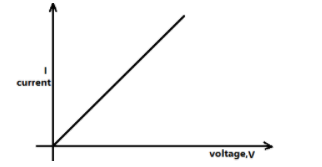
Give the nature of V-I graph for.
(i)ohmic
(ii)non-ohmic
circuit elements. Give an example of each.
Answer
580.2k+ views
Hint: ohmic circuit elements are the elements which follow the ohm’s law and the non-ohmic are those circuit elements that don't follow the ohm’s law. Ohm’s law states that the electric current is proportional to voltage and inversely proportional to resistance.
Complete step-by-step answer:
(i). From the ohm’s law we have the relation between the current, resistance, and voltage through any electrical circuit, which is as follows,
According to ohm’s law,
$V = IR$
On looking at the above equation we find that this equation is of the $y = mx$ type equation which gives a straight line.
So, if we plot a graph between voltage, $V$ and current, $I$, we will get as follows,

Hence the graph of the ohmic circuit elements will be straight-line passing through the origin.
Example for the ohmic circuit element- metallic conductors (such as silver, aluminium, copper, iron etc.).
(ii). For the non-ohmic circuit elements, as they will not follow the ohm’s law so they will not have the same equation as that of the ohmic circuit elements for plotting the graph. So, the graphs of the non-ohmic circuit elements will be other than the graphs of the ohmic circuit elements.
That means the graph of a non-ohmic circuit element will be a non-linear curve or the straight line which is not passing through the origin.

Example of the non-ohmic circuit element- Diodes and Transistors.
Note: When we are comparing the ohmic and non-ohmic resistors in a circuit or the ohmic and non-ohmic devices then we have to keep in mind that the distinction between them only can be done if the conditions of the resistors are constant. If conditions of the resistor are not constant then there is no point of comparing the ohmic and non-ohmic resistance.
Complete step-by-step answer:
(i). From the ohm’s law we have the relation between the current, resistance, and voltage through any electrical circuit, which is as follows,
According to ohm’s law,
$V = IR$
On looking at the above equation we find that this equation is of the $y = mx$ type equation which gives a straight line.
So, if we plot a graph between voltage, $V$ and current, $I$, we will get as follows,

Hence the graph of the ohmic circuit elements will be straight-line passing through the origin.
Example for the ohmic circuit element- metallic conductors (such as silver, aluminium, copper, iron etc.).
(ii). For the non-ohmic circuit elements, as they will not follow the ohm’s law so they will not have the same equation as that of the ohmic circuit elements for plotting the graph. So, the graphs of the non-ohmic circuit elements will be other than the graphs of the ohmic circuit elements.
That means the graph of a non-ohmic circuit element will be a non-linear curve or the straight line which is not passing through the origin.

Example of the non-ohmic circuit element- Diodes and Transistors.
Note: When we are comparing the ohmic and non-ohmic resistors in a circuit or the ohmic and non-ohmic devices then we have to keep in mind that the distinction between them only can be done if the conditions of the resistors are constant. If conditions of the resistor are not constant then there is no point of comparing the ohmic and non-ohmic resistance.
Recently Updated Pages
Master Class 12 English: Engaging Questions & Answers for Success

Master Class 12 Business Studies: Engaging Questions & Answers for Success

Master Class 12 Economics: Engaging Questions & Answers for Success

Master Class 12 Social Science: Engaging Questions & Answers for Success

Master Class 12 Maths: Engaging Questions & Answers for Success

Master Class 12 Chemistry: Engaging Questions & Answers for Success

Trending doubts
What are the major means of transport Explain each class 12 social science CBSE

Differentiate between homogeneous and heterogeneous class 12 chemistry CBSE

Draw a ray diagram of compound microscope when the class 12 physics CBSE

How is democracy better than other forms of government class 12 social science CBSE

What is virtual and erect image ?

Explain the energy losses in the transformer How are class 12 physics CBSE




